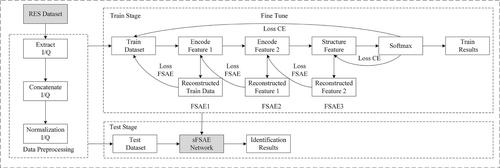当前位置:
X-MOL 学术
›
IET Radar Sonar Navig.
›
论文详情
Our official English website, www.x-mol.net, welcomes your feedback! (Note: you will need to create a separate account there.)
Radar emitter structure identification based on stacked frequency sparse auto-encoder network
IET Radar Sonar and Navigation ( IF 1.7 ) Pub Date : 2023-11-23 , DOI: 10.1049/rsn2.12508 Lutao Liu 1, 2 , Wei Zhang 1, 2 , Yu Song 3 , Yilin Jiang 1, 2 , Xiangzhen Yu 4
IET Radar Sonar and Navigation ( IF 1.7 ) Pub Date : 2023-11-23 , DOI: 10.1049/rsn2.12508 Lutao Liu 1, 2 , Wei Zhang 1, 2 , Yu Song 3 , Yilin Jiang 1, 2 , Xiangzhen Yu 4
Affiliation

|
In the current complex situations of electronic intelligence (ELINT), the authors present a radar emitter structure (RES) identification method based on deep learning at a new level to address the issue of incomplete cognitive information. Firstly, due to the fact that existing simulation data cannot fully reflect the structure features of the entire radar emitter, the structure feature-level RES model is built using direct digital synthesiser (DDS) technology and radio frequency (RF) simulation platform. Afterwards, considering that the structure features are reflected in the frequency domain, a stacked frequency sparse auto encoder (sFSAE) network is constructed by adding a constraint term in frequency domain to the loss function of sparse auto encoder (SAE). Using deep learning to extract structure features with constraints in different domains is instructive for feature extraction techniques under variable operating parameters. Finally, the extracted structure features are input into the Softmax classifier to perform the identification from the radar signal to the RES. The experimental results show that the proposed method has high generalisation ability and robustness under different modulation types, different operating parameters and different signal to noise ratio (SNR). It also has a high identification rate even for untrained modulated signals.
中文翻译:

基于堆叠频率稀疏自编码网络的雷达发射源结构识别
针对当前电子情报(ELINT)复杂的情况,作者提出了一种新水平的基于深度学习的雷达发射体结构(RES)识别方法,以解决认知信息不完整的问题。首先,由于现有的仿真数据无法全面反映整个雷达发射体的结构特征,因此采用直接数字合成器(DDS)技术和射频(RF)仿真平台构建了结构特征级RES模型。随后,考虑到结构特征反映在频域中,通过在稀疏自动编码器(SAE)的损失函数中添加频域约束项,构建了堆叠频率稀疏自动编码器(sFSAE)网络。使用深度学习提取不同领域中具有约束的结构特征对于可变操作参数下的特征提取技术具有指导意义。最后,将提取的结构特征输入到Softmax分类器中,进行从雷达信号到RES的识别。实验结果表明,该方法在不同调制类型、不同工作参数和不同信噪比(SNR)下具有较高的泛化能力和鲁棒性。即使对于未经训练的调制信号也具有很高的识别率。
更新日期:2023-11-25
中文翻译:

基于堆叠频率稀疏自编码网络的雷达发射源结构识别
针对当前电子情报(ELINT)复杂的情况,作者提出了一种新水平的基于深度学习的雷达发射体结构(RES)识别方法,以解决认知信息不完整的问题。首先,由于现有的仿真数据无法全面反映整个雷达发射体的结构特征,因此采用直接数字合成器(DDS)技术和射频(RF)仿真平台构建了结构特征级RES模型。随后,考虑到结构特征反映在频域中,通过在稀疏自动编码器(SAE)的损失函数中添加频域约束项,构建了堆叠频率稀疏自动编码器(sFSAE)网络。使用深度学习提取不同领域中具有约束的结构特征对于可变操作参数下的特征提取技术具有指导意义。最后,将提取的结构特征输入到Softmax分类器中,进行从雷达信号到RES的识别。实验结果表明,该方法在不同调制类型、不同工作参数和不同信噪比(SNR)下具有较高的泛化能力和鲁棒性。即使对于未经训练的调制信号也具有很高的识别率。



























 京公网安备 11010802027423号
京公网安备 11010802027423号